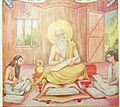Mahabharata facts for kids
| Hindu texts |
| Śruti
Smriti |
The Mahabharata is one of the two most important ancient epic poems from India. The other famous epic is the Ramayana. The word "Mahabharata" means "the great story of the Bharata family."
This epic was put together in Ancient India. Many people believe that a wise sage (teacher) named Vyasa wrote it. Legend says that the god Ganesha helped by writing down the story as Vyasa dictated it. The Mahabharata is one of the longest poems in the world. It has about 110,000 verses, called couplets, divided into eighteen main sections. There's also a 19th section called Harivamsha. A very important part of the Mahabharata is the Bhagavad Gita, which is a conversation between Krishna and Arjuna.
Sage Vyasa taught this epic to his son, Suka, and his students, including Vaisampayana. Later, Vaisampayana told the story to King Janamejaya, who was a grandson of the heroes in the epic. Another sage named Suta also retold the Mahabharata to different groups of people.
What is the Mahabharata About?
The Mahabharata covers many different topics. It explores various parts of Hinduism, including its stories and beliefs. The epic also teaches about good behavior and the Hindu way of life. It's a huge collection of wisdom and tales.
The Mahabharata is divided into eighteen main sections. These sections are called parvan or parva, which means "book." Each parva tells a different part of the epic story.
Here are the names of the eighteen parvas and what they are about:
| Parva | Title | Main Story |
| 1 | Adi-parva | Introduction to the story, including the birth and childhood of the princes. |
| 2 | Sabha-parva | Life at the royal court, a game of dice, and the start of the Pandavas' exile. |
| 3 | Aranyaka-parva | The twelve years the Pandavas spent living in the forest. |
| 4 | Virata-parva | The year the Pandavas spent secretly living at the court of King Virata. |
| 5 | Udyoga-parva | The preparations and efforts made before the great war began. |
| 6 | Bhishma-parva | The first part of the big battle, with Bhishma leading the Kaurava army. |
| 7 | Drona-parva | The battle continues, with Drona taking over as the Kaurava commander. |
| 8 | Karna-parva | The battle goes on, with Karna leading the Kaurava forces. |
| 9 | Shalya-parva | The final part of the battle, with Shalya as the last Kaurava commander. |
| 10 | Sauptika-parva | How Ashvattama attacked and killed the remaining Pandava army while they slept. |
| 11 | Stri-parva | Gandhari and other women mourn and cry for those who died in the war. |
| 12 | Shanti-parva | Yudhisthira becomes king, and Bhishma gives him important lessons on ruling. |
| 13 | Anusasana-parva | Bhishma gives his final teachings and advice to Yudhisthira. |
| 14 | Ashvamedhika-parva | King Yudhisthira performs a special royal horse sacrifice ceremony. |
| 15 | Ashramavasika-parva | Dhritarashtra, Gandhari, and Kunti leave for a quiet forest retreat, where they eventually pass away. |
| 16 | Mausala-parva | The Yadava clan fights among themselves using maces, leading to their destruction. |
| 17 | Mahaprasthanika-parva | Yudhisthira and his brothers begin their final journey towards death. |
| 18 | Svargarohana-parva | The Pandavas finally reach the spiritual world. |
| 19 | Harivamsha | This section tells the story of Krishna's life. |
Who are the Pandavas?
The Pandavas are five brothers who are central heroes in the Mahabharata. Their mother, Kunti, had a special power. She could call upon gods to have children. Her first son, Karna, was born from the Sun God, Surya, before she was married.
Later, Kunti used her special power again to have her five sons, the Pandavas:
- Yudhisthira was the son of the god Yama.
- Bhima was the son of Vayu, the god of wind.
- Arjuna was the son of Indra, the king of the gods.
Kunti's co-wife, Madri, also had two sons using the same power. Their fathers were the Ashwins, who were divine twins. Madri's sons were:
- Nakula
- Sahadeva
These five brothers are known as the Pandavas, and their adventures and struggles form the core of the Mahabharata story.
Images for kids
-
Krishna and Arjuna at Kurukshetra, 18th–19th-century painting.
-
Modern depiction of Vyasa narrating the Mahābhārata to Ganesha at the Murudeshwara temple, Karnataka.
-
Draupadi with her five husbands – the Pandavas. The central figure is Yudhishthira; the two on the bottom are Bhima and Arjuna. Nakula and Sahadeva, the twins, are standing. Painting by Raja Ravi Varma, c. 1900.
-
Arjuna piercing the eye of the fish as depicted in Chennakesava Temple built by Hoysala Empire
-
A scene from the Mahābhārata war, Angkor Wat: A black stone relief depicting several men wearing a crown and a dhoti, fighting with spears, swords, and bows. A chariot with half the horse out of the frame is seen in the middle.
-
Gandhari, blindfolded, supporting Dhritarashtra and following Kunti when Dhritarashtra became old and infirm and retired to the forest. A miniature painting from a 16th-century manuscript of part of the Razmnama, a Persian translation of the Mahabharata
-
Krishna as portrayed in Yakshagana from Karnataka which is based largely on stories of Mahabharata
See also
 In Spanish: Mahabharata para niños
In Spanish: Mahabharata para niños
















